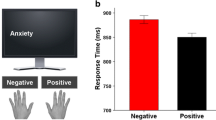Abstract
Prolonged presentation of visually ambiguous figures leads to perceptual switching. Individual switching rates show great variability. The present study compares individuals with high versus low switching rates by investigating human scalp electroencephalogram and blink rates. Eight subjects viewed the Necker cube continuously and responded to perceptual switching by pressing a button. Frequent switchers showed characteristic occipital alpha and frontal theta band activity prior to a switch, whereas infrequent switchers did not. The alpha activity was specific to switching, the theta activity was generic to perceptual processing conditions. A negative correlation was observed between perceptual switching and blink rates. These results suggest that the ability to concentrate attentional effort on the task is responsible for the differences in perceptual switching rates
Similar content being viewed by others
References
Attneave F. (1971). Multistability in perception. Sci Am 225:63–71
Bartnik EA., Blinowska KJ., Durka PJ. (1992). Single evoked potential reconstruction by means of wavelet transform. Biol Cybern 67:175–181
Borsellino A., De Marco A., Allazetta A., Rinesi S., Bartolini B. (1972). Reversal time distribution in the perception of visual ambiguous stimuli. Kybernetik 10:139–144
Brown KT. (1955). Rate of apparent change in a dynamic ambiguous figure as a function of observation-time. Am J Psychol 68:358–371
Chui CK., Wang JZ. (1992). On compactly supported spline wavelets and a duality principle. Trans Amer Math Soc 330:903–915
Corbetta M., Shulman GL. (2002). Control of goal-directed and stimulus-driven attention in the brain. Nat Rev Neurosci 3:201–215
Efron B. (1979). Bootstrap methods: another look at the jackknife. The Annals of Statistics 7:1–26
Efron B., Tibshirani R. (1986). Bootstrap methods for standard errors, confidence intervals, and the other measures of statistical accuracy. Statistical Science 1:54–77
Einhäuser W., Martin KA., König P. (2004). Are switches in perception of the Necker cube related to eye position?. Eur J Neurosci 20:2811–2818
Horlitz KL., O’Leary A. (1993). Satiation or availability? Effects of attention, memory, and imagery on the perception of ambiguous figures. Percept Psychophys 53:668–681
Inanaga K.(1998). Frontal midline theta rhythm and mental activity. Psychiatry Clin Neurosci 52:555–566
İşoğlu-Alkaç, Başar-Eroğlu C., Ademoğlu A., Demiralp T., Miener M., Stadler M. (1998). Analysis of the electroencephalographic activity during the Necker cube reversals by means of the wavelet transform. Biol Cybern 79:437–42
Isoglu-Alkaç Ü., Basar-Eroglu C., Ademoglu A., Demiralp T., Miener M., Stadler M. (2000). Alpha activity decreases during the perception of Necker cube reversals: an application of wavelet transform. Biol Cybern 82:313–320
Ito J., Nikolaev AR., Luman M., Aukes MF., Nakatani C., van Leeuwen C. (2003). Perceptual switching, eye movements, and the bus paradox. Perception 32:681–698
Jensen O., Tesche CD. (2002). Frontal theta activity in humans increases with memory load in a working memory task. Eur J Neurosci 15:1395–1399
Kahana MJ., Seelig D., Madsen JR. (2001). Theta returns. Curr Opin Neurobiol 11:739–744
Kleinschmidt A., Buchel C., Zeki S., Frackowiak RS. (1998). Human brain activity during spontaneously reversing perception of ambiguous figures. Proc R Soc Lond B Biol Sci 265:2427–2433
Kornmeier J., Bach M. (2004). Early neural activity in Necker-cube reversal: evidence for low-level processing of a gestalt phenomenon. Psychophysiology 41:1–8
Kornmeier J., Bach M. (2005). The Necker cube-an ambiguous figure disambiguated in early visual processing. Vision Res 45:955–960
Lehky SR. (1995). Binocular rivalry is not chaotic. Proc R Soc Lond B Biol Sci 259:71–76
Leopold DA. Logothetis NK. (1999). Multistable phenomena: changing views in perception. Trends Cogn Sci 3:254–264
Leopold DA., Wilke M., Maier A., Logothetis NK. (2002). Stable perception of visually ambiguous patterns. Nat Neurosci 5:605–609
Lewicki MS. (1998). A review of methods for spike sorting: the detection and classification of neural action potentials. Network 9:R53–R78
Lumer ED., Friston KJ., Rees G. (1998). Neural correlates of perceptual rivalry in the human brain. Science 280:1930–1934
Meenan JP., Miller LA. (1994). Perceptual flexibility after frontal or temporal lobectomy. Neuropsychologia 32:1145–1149
Mizuhara H., Wang LQ., Kobayashi K., Yamaguchi Y. (2004). A long-range cortical network emerging with theta oscillation in a mental task. Neuroreport 15:1233–1238
Murata T., Matsui N., Miyauchi S., Kakita Y., Yanagida T. (2003). Discrete stochastic process underlying perceptual rivalry. Neuroreport 14:1347–1352
Nakatani H., Watanabe T., Hoshimiya N. (2001). Detection of nerve action potentials under low signal-to-noise ratio condition. IEEE Trans Biomed Eng 48:845–9
Press WH., Teukolshy SA., Vetterling WT, Flannery BP (1993) Numerical Recipes in C (Japanese translation). Gijutsu Hyoron Sha
Ricci C., Blundo C. (1990). Perception of ambiguous figures after focal brain lesions. Neuropsychologia 28:1163–1173
Rock I., Hall S., Davis J. (1994). Why do ambiguous figures reverse. Acta Psychol (Amst) 87:33–59
Sasaki K., Tsujimoto T., Nishikawa S., Nishitani N., Ishihara T. (1996). Frontal mental theta wave recorded simultaneously with magnetoencephalography and electroencephalography. Neurosci Res 26:79–81
Stern JA., Walrath LC., Goldstein R. (1993). The endogenous eyeblink. Psychophysiology 21:22–33
Strüber D., Basar-Eroglu C., Hoff E., Stadler M. (2000). Reversal-rate dependent differences in the EEG gamma-band during multistable visual perception. Int J Psychophysiol 38:243–252
Yamada F. (1998). Frontal midline theta rhythm and eyeblinking activity during a VDT task and a video game: useful tools for psychophysiology in ergonomics. Ergonomics 41:678–688
Yamagishi N., Callan DE., Goda N., Anderson SJ., Yoshida Y., Kawato M. (2003). Attentional modulation of oscillatory activity in human visual cortex. Neuroimage 20:98–113
Zhou YH., Gao JB., White KD., Merk I., Yao K. (2004). Perceptual dominance time distributions in multistable visual perception. Biol Cybern 90:256–263
Author information
Authors and Affiliations
Corresponding author
Rights and permissions
About this article
Cite this article
Nakatani, H., Leeuwen, C. Individual differences in perceptual switching rates; the role of occipital alpha and frontal theta band activity. Biol Cybern 93, 343–354 (2005). https://doi.org/10.1007/s00422-005-0011-2
Received:
Accepted:
Published:
Issue Date:
DOI: https://doi.org/10.1007/s00422-005-0011-2




